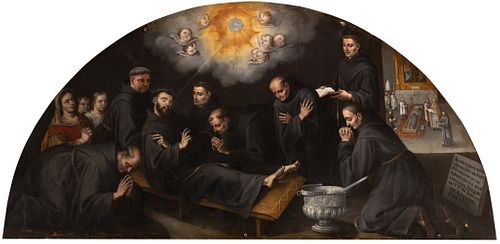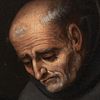JUAN RUIZ SORIANO (Higuera de la Sierra, Huelva, 1701 - Seville, 1763). "The death of St. Francis", 1743. Oil on canvas. Relined.
Lot 85
About Seller
Setdart Auction House
Carrer Aragó 346
Barcelona
Spain
Setdart Subastas was born in 2004 and is currently the first online art auction in Spain with solidity, prestige and reliability guaranteed by our more than 60,000 users. Setdart has a young, dynamic and enterprising team ready to successfully manage the purchase and sale of art works through custom...Read more
Estimate:
EUR€35,000 - EUR€40,000
$36,458.33 - $41,666.67
Absentee vs Live bid
Two ways to bid:
- Leave a max absentee bid and the platform will bid on your behalf up to your maximum bid during the live auction.
- Bid live during the auction and your bids will be submitted real-time to the auctioneer.
Bid Increments
| Price | Bid Increment |
|---|---|
| EUR€0 | EUR€10 |
| EUR€200 | EUR€25 |
| EUR€500 | EUR€50 |
| EUR€1,000 | EUR€100 |
| EUR€3,000 | EUR€200 |
| EUR€5,000 | EUR€500 |
| EUR€10,000 | EUR€1,000 |
| EUR€20,000 | EUR€2,000 |
| EUR€50,000 | EUR€5,000 |
About Auction
By Setdart Auction House
Nov 3, 2021
Set Reminder
2021-11-03 08:00:00
2021-11-03 08:00:00
America/New_York
Bidsquare
Bidsquare : OLD MASTERS
https://www.bidsquare.com/auctions/setdart-auction-house/old-masters-7786
Setdart Auction House sofia@setdart.com
Setdart Auction House sofia@setdart.com
- Lot Description
JUAN RUIZ SORIANO (Higuera de la Sierra, Huelva, 1701 - Seville, 1763). "The death of St. Francis", 1743. Oil on canvas. Relined. Presents repainting and restorations. Presents inscription with date. Measurements. 139 x 275 cm. The semicircular format of this work indicates that it is a painting designed as a decorative element, perhaps with the intention of ornamenting the upper areas of a vain, or other architectural space. Of devotional character, the author has portrayed the death of Saint Francis, who is lying in the center of the composition, with his eyes closed and his hands with the stigmata on his chest. Saint Francis, the protagonist of the scene, is surrounded by numerous religious of his order who are watching over the corpse, all of them adopting a different attitude and different physical features, which shows the mastery of the author. The central image, of sober and austere character, is relieved by the author through three elements; the glory break located in the superior zone, the family that is arranged in the left zone, that perhaps represent some donors, whose clothes stand out on the rigorous black of the friars, and finally the presence of a small space in the right area, where the official burial of San Francisco can be appreciated, already in his coffin. Born in the town of Higuera de Aracena, currently Higuera de la Sierra, Juan Ruiz Soriano trained in Seville with his cousin Alonso Miguel de Tovar (Higuera de la Sierra, 1678 - Madrid, 1752), beginning his pictorial activity in 1725. Being a disciple of Tovar it is logical that the art of Ruiz Soriano derives, at the same time, from that of Murillo, and for that reason in his pictorial production a soft and kind drawing is noticed. We know that he worked for numerous religious orders, who turned to him to make series of paintings to decorate the cloister walls. He must also have worked with great insistence for private individuals. In this canvas we can appreciate the direct influences of both Ruiz Soriano and Tovar, so it could be deduced that the author is a painter of the circle of the first, and a follower like him of the second. Both masters derived their models from Murillo, as was common among Sevillian painters of the eighteenth century, a mark that is also evident in this canvas both in the treatment, drawing and very worked tonalities of classical roots, and in the characters themselves, worked with a marked sense of expressive affability and serenity. Within the production of Alonso Miguel de Tovar we frequently find the same theme that this painting deals with, represented also following a very similar compositional model. In the "Divinas Pastoras" of the parish church of Cortelazor, the one of Higuera de la Sierra and the one preserved in the Prado Museum, all typical of Tovar's style, Mary appears seated on a rock on a landscape background closed on the left, dressed in a pink tunic, blue cloak and sheepskin sackcloth, holding a rose in her left hand and caressing the head of a sheep with her right hand. In all of them, in addition, the animals that approach the figure carry roses in their mouths, as an offering to Mary. The rest of the elements of the composition are identical to those of Tovar, including the secondary scene located in the background, in which an archangel appears fighting against a demon that intends to attack a lamb that holds in its mouth a phylactery with the text "Ave Maria". Thus, the only iconographic differences with respect to the work of Tovar are the crown of the Virgin and the archangel, who in the work of the master of Higueras de la Sierra carries a flaming sword, while here he appears unarmed. Another differentiating element, although secondary in terms of iconography, is that in this work an angel appears holding Mary's staff, while in Tovar's works the staff appears leaning on the rock.
- Shipping Info
-
In-house shipping available. Please inquire at admin@setdart.com.
-
- Buyer's Premium



 EUR
EUR CAD
CAD AUD
AUD GBP
GBP MXN
MXN HKD
HKD CNY
CNY MYR
MYR SEK
SEK SGD
SGD CHF
CHF THB
THB

















